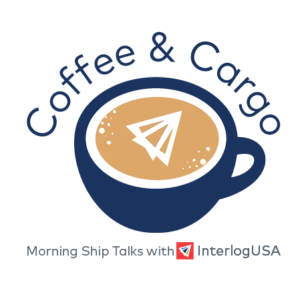Competitive Edge
June 15th, 2022
Stay Current with Interlog’s Weekly Newsletter:
Headlines
- Congress approved, by a large margin, the Ocean Shipping Reform Act (OSRA). This legislation is essentially the Senate’s version of a reform bill passed by the House in December, Freight Waves reports.
UPDATE: U.S./Canada Ports – Number of Vessels at Anchor as of 06-14-22
- Savannah: 26 Vessels at Anchor (+8)
- New York/Newark: 18 Vessels at Anchor (+2)
- Houston: 15 Vessels at Anchor (-5)
- Vancouver: 15 Vessels at Anchor (-9)
- Los Angeles/Long Beach: 8 Vessels at Anchor (-2)
- San Francisco/Oakland: 8 Vessels at Anchor (-1)
- Charleston: 1 Vessels at Anchor (+1)
Note: This does not include vessels moored and being unloaded at port docks.
Courtesy: MarineTraffic
IMPORT: Asia to North America (TPEB)
Recent Developments:
- Shanghai has reopened after its two-month Covid-related lockdown. All businesses in the city have resumed work June 1, including manufacturing, production, and warehousing.
- From Triple Eagle (Group) Ltd., manufacturing and production in the city will take “some time” before returning to normal operations.
- Truck drivers will still need a Covid-negative NAT (nucleic acid test) report within 72 hours of gating in warehouses.
- With Shanghai loosening restrictions, many forecast a surge of pent-up demand will occur pressuring operations and increasing overall rates.
- Contract negotiations between the International Longshore and Warehouse Union (ILWU) and Pacific Maritime Association (PMA) remain active.
Rates: Rates remain relatively elevated compared to pre-pandemic levels. MSC plans to implement GRIs from Indian origins to U.S. destinations in July.
Space: With Shanghai loosened up, expected demand surges will tighten space.
Capacity: Capacity has tightened in pockets as more shippers shift to the USEC (due to uncertainty around West Coast labor talks).
Equipment: Intermodal systems remain stressed with truck and chassis availability dire.
TIPS: Book at least 3 weeks prior to CRD. Strongly consider premium service and alternative routings. Additionally, be in close contact with suppliers to check up on any Covid-related developments that can affect production.
IMPORT: Europe to North America (TAWB)
Recent Developments:
- USWC ports have seen alleviated congestion.
- On the USWC, wait times for vessels have vastly improved. In some cases, wait times have cut down to under 10 days at Los Angeles/Long Beach ports.
- On the USEC, the ports of Savannah and New York/Newark are both experiencing considerable congestion.
- Conversely, the Port of Charleston has sustained improvements to its operations and has enjoyed minimal congestion.
Rates: Rates are expected to stay elevated throughout June and into July.
Space: Space remains critical for USEC and USWC. However, there have been glimpses of improvements.
Capacity: Capacity for both North Europe and Mediterranean services remain gripped.
Equipment: Equipment remains available at European seaports. However, inland terminals in Europe are still reporting equipment shortages.
TIPS: Book 5 or more weeks prior to CRD. Shippers are strongly advised to use premium service for no-roll options and improved reliability for their cargo.
EXPORT: North America to Asia
Recent Developments:
- For the USEC, congestion remains considerable at New York-Newark and Savannah ports.
- Diminished schedule integrity continues to challenge post earliest return dates.
- Stifling vessel backlogs in Shanghai have led to increased occurrences of blank sailings.
- Vessel arrivals remain smooth for USWC POLs.
Rates: Some carriers have issued GRIs for June.
Capacity: Available capacity remains fluid for USWC POLs.
Equipment: Truck and chassis availability remain causes for concern and has significantly contributed to congestion of the intermodal system and IPI origins.
TIPS: Book 4 to 5 weeks prior to ETD to secure equipment and vessel space.
Did You Know: Labor and Maritime leaders are discussing an expansion of hours at U.S. West Coast Ports
This potential plan would allow all USWC marine terminal to open an hour earlier, at 6 a.m. – called a “double flex.”
This would open port gates to more truck drivers, which would add more time to their most productive time of the day.
Source: Transport Topics
Freight News
Workers at the Port of Hamburg walk out in a warning strike, plus a Shanghai update and Korea trucker strike ends with an agreement being reached
Workers at the Port of Hamburg walk out in a warning strike:
Last Thursday, workers at the Port of Hamburg, which is Europe’s third-largest container port and largest railway port, followed through on their threat of a strike. The striking workers have also impacted the German ports of Emden, Bremen, Bremerhaven and Wilhelmshaven, Freightwaves reported.
Now, the strike still looms over German ports and terminal. German port employers and the union representing the dockworkers are planning on holding another round of negotiations, in an effort to hold off a potentially crippling strike, the JOC reports. This comes after talks shut down over the weekend. As of now, it’s not immediately clear when the new talks would be scheduled.
Shanghai update:
Over the weekend, Shanghai’s 15 of their 16 districts affected the flow of exports bound for the Port of Shanghai, Freightwaves reports. Drivers are still required to have a negative NAT (nucleic acid test) report within 72 hours, health code and travel code when gating in warehouses as well.
Korea trucker strike ends:
A weeklong trucker strike in South Korea has ended after they reached an agreement with the government, the American Journal of Transportation reports.
Truckers will immediately go back to their duties after they agreed to extend a freight rate system that will guarantee minimum wages, a statement from the Cargo Truckers Solidarity division of the Korean Public Service and Transport Workers Union says and reported by the AJOT.
Additionally in the agreement, the transport ministry will provide subsidies which will help to alleviate pressure on surging fuel costs.
Chassis Shortage Continues as Norfolk Southern Puts Limits on International Intermodal Volumes
Last Thursday, Norfolk Southern announced limits on international intermodal volumes shipped through five inland markets, because of a shortage of marine chassis – which has been a continued issue for many North American Class I railroads this year.
This affects imports from the Port of New York and New Jersey and the Port of Virgina going to Columbus, Cleveland, Pittsburgh, and St. Louis, the Journal of Commerce reports. Additionally, exports from Memphis to Savannah on NS will be limited to 75 containers per day, which is down from the cap of 100 containers back in early May.
An issue that has been occurring at Norfolk Southern’s Rossville and St. Louis ramps is slow pickups filling the container stack in Memphis. This is when a shipper leaves the container in the terminal (resulting in storage fees, a form of demurrage), and which can result in the railroad running low on space, the JOC notes.
The railroad is hoping that restricting exports to Savannah will create “maneuvering room” to clear the containers that are sitting on railcars.
We touched on this topic in our webinar today, June 15th, so if you would like to hear this topic discussed further by our experts you will find a link to the recording of that webinar at the bottom of this page.
During our webinar today, our experts discussed the chassis shortage that has been occurring. You can watch the webinar here for more information regarding that topic as well as other current updates in the industry.
Blog Of The Week

Port of Oakland, Seattle-Tacoma, and The USDA Working Together to Provide Incentives for U.S. Growers Shipping Products Through the Ports
Watch today's webinar!

We discussed import conditions, what the second half of summer looks like/what to expect, current events and had a live Q&A with our experts!
Sign up for our
industry answers
Our team works to provide valuable, unique, and relevant content to assist you in finding solutions. Sign up now.